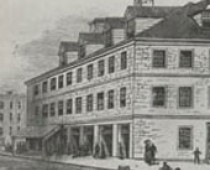Henry Fite House facts for kids
Quick facts for kids "Henry Fite House" (later Tavern/Hotel) |
|
|---|---|
 |
|
| Alternative names | "Congress Hall" "Old Congress Hall" |
| General information | |
| Type | tavern |
| Architectural style | Georgian (red brick with white wood trim) |
| Location | Southwest corner, West Baltimore (then known as Market) Street, and Liberty - South Sharp Streets, (later also known as Hopkins Place) |
| Address | (current site): Baltimore Civic Center [1962], (now Royal Farms Arena) |
| Town or city | Baltimore Town, county seat of Baltimore County, |
| Country | USA |
| Coordinates | 39°17′19″N 76°37′8″W / 39.28861°N 76.61889°W |
| Current tenants | burned by fire |
| Completed | c. 1770 |
| Destroyed | Sunday/Monday, February 7–8, 1904, Great Baltimore Fire |
| Owner | Henry Fite, (1722–1789), later: daughter, Elizabeth Fite Reinicker |
| Height | three-and-half stories |
| Dimensions | |
| Other dimensions | 92 ft. X 50/55 ft. |
| Technical details | |
| Floor count | 3 plus attic and cellar |
The "Henry Fite House" was an important building in Baltimore, Maryland. It was built around 1770 by Henry Fite. This large building was first used as an inn and tavern. It was made of red brick with white wood trim, in a style called Georgian.
This house became very famous during the Revolutionary War. It was known as "Congress Hall" because the Second Continental Congress met there. This was the group of leaders who helped create the United States. They met in the Henry Fite House from December 1776 to February 1777. Later, people called it "Old Congress Hall." Sadly, the building was destroyed in the Great Baltimore Fire in 1904.
Contents
Baltimore: A Nation's Capital
In the winter of 1776, the Second Continental Congress had to leave Philadelphia. British soldiers were getting close to Philadelphia, which was the new American capital. To stay safe, the Congress moved to Baltimore.
The Henry Fite House was the biggest building in Baltimore at that time. It was perfect for the Congress to meet. It was also far enough from the Patapsco River that British ships couldn't easily attack it. A visitor described it as a large brick house with three stories and an attic. It had 14 rooms, plus a kitchen and other small buildings. There was even a stable for 30 horses!
George Washington's Powers
For about two months, Baltimore was the capital of the new nation. While meeting here, the Continental Congress gave General George Washington special powers. This was a big vote of trust for Washington. He was the leader of the Continental Army. This happened after some tough battles and retreats for the American forces.
Who Owned the House?
Some historians used to think Jacob Fite owned the house. But Elizabeth Fite, a family member, later explained the truth. Henry Fite's son, Jacob, did live there. However, he was just a child when Congress met in the house. He never actually owned it. After Henry Fite passed away in 1789, his eldest daughter, Elizabeth, and her husband, George Reinicker, became the owners.
George Peabody's Home
A very famous person named George Peabody lived in the Henry Fite House. He was a rich businessman and a philanthropist. A philanthropist is someone who gives a lot of money to help others. George Peabody moved to Baltimore in 1816.
The Henry Fite House was his home and office for about 20 years. From there, he managed his growing business and investments. By the middle of the 1800s, he became one of the richest people in America.
Peabody Institute
George Peabody later used his wealth to help Baltimore. In 1857, he started the Peabody Institute. This place opened nine years later. It included a library and offered educational and cultural programs. The Institute was built near the Washington Monument in Baltimore.
Peabody moved to New York City and then to London in 1837. His international business needed more of his time. He returned to Baltimore in 1866, three years before he died. He spoke to a large crowd, including many school children, at the dedication of his new Institute.
Royal Farms Arena Today
Today, the place where the Henry Fite House once stood is a large arena. It is called the Royal Farms Arena. It was first known as the Baltimore Civic Center when it was built in 1961–62.
This building is a big part of Baltimore's sports and entertainment. It covers a whole city block in downtown Baltimore.
A Special Memorial Tablet
On February 22, 1894, a special bronze tablet was placed in front of the Henry Fite House. The Maryland Society of the Sons of the American Revolution put it there. This tablet told people about the building's important role in American history.
It said: "On this site stood Old Congress Hall, in which the Continental Congress met." Just ten years later, the Great Baltimore Fire destroyed the house. Only the memorial tablet was left among the ruins.
When the Civic Center (now Royal Farms Arena) was built, the tablet was saved. It was put on the outside wall of the new building. Later, during a remodel, the plaque was moved inside the building's lobby.

